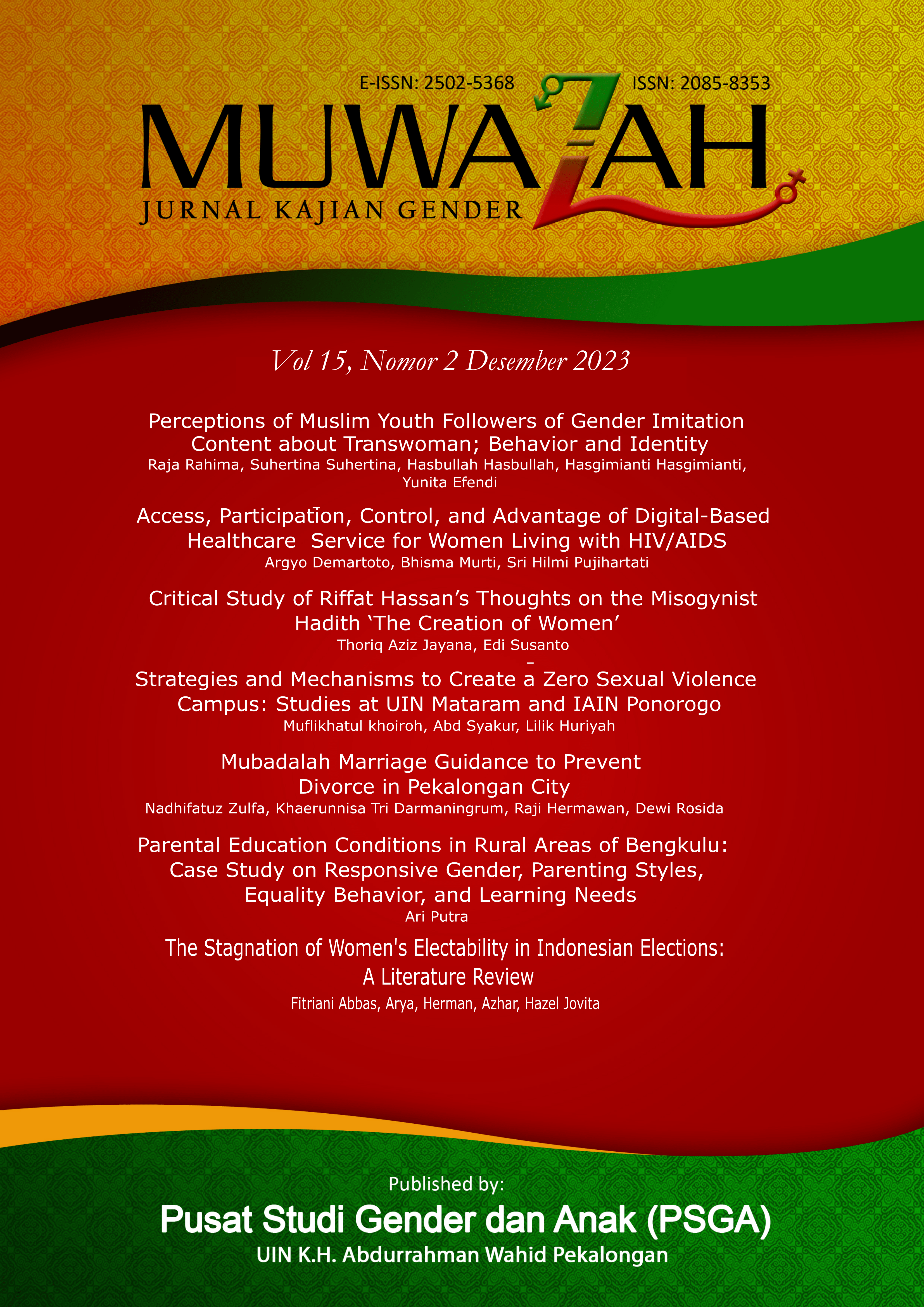Critical Study of Riffat Hassan’s Thoughts on the Misogynist Hadith ‘The Creation of Women’
DOI:
https://doi.org/10.28918/muwazah.v15i2.1927Keywords:
Riffat Hassan, , misogynistic hadith,, gender equalityAbstract
The purpose of writing this article is to examine Riffat Hassan's thoughts, as well as criticize his views on the hadith on the 'creation of women' which he considers to be a misogynist hadith. This was done by Riffat with the aim of deconstructing and offering another interpretation, with feminist analysis, in order to produce an egalitarian understanding. The method used in this paper is qualitative with a literature study approach. The main data used in this study are Hassan's thoughts contained in the book entitled Women's and Men's Liberation and the book Equal Before Allah. These two articles clearly illustrate Riffat Hassan's thoughts on misogynistic hadith. The data analysis used is by presenting the data (Riffat Hassan's views on the hadith on the creation of women), then examining in depth the truth of the data, then criticizing this view. The results of this research are (1) explaining the influence of thought and cultural background which influenced Riffat Hassan's feminist thinking, (2) explaining the results of Riffat's reinterpretation of the theory of the creation of women, and his rejection of traditional interpretations which seem to demean women, (3) various criticisms of Riffat's thoughts regarding the misogynistic hadith 'creation of women', starting from criticism of sanad to problematic matan.
References
Al-Bukhari, M. I. (no year).Shahih Al-Bukhari. Vol 3. Beirut: Dar Al-Fikr.
Al-Dimasyqi, I. K. (1998). Tafsir Al-Quran Al-‘Adhim. Vol 3. Beirut: Dar Al-Kutub Al-Ilmiyah.
Al-Dzahabi, A. A. (no year). Mizan Al-I’tidal fi Naqd Ar-Rijal. Vol 2. Beirut: Dar Al-Fikr.
Al-Razi, A. B. (2000). Mukhtar Ash-Shihah. Cairo: Dar Al-Hadist.
Amin, Q. (2003). Sejarah Penindasan Perempuan. (Translated by Syaiful Alam). Yogyakarta: IRCiSod.
Ansori, D. S. (1997). Membincangkan Feminisme. Bandung: Pustaka Hidayah.
Anwar, M. S., Maghfiroh, R. (2023). Riffat Hassan's Thoughts on the Feminist Paradigm. Al-Wajih: The Journal of Islamic Studies, 1(1), 23-30. https://www.jurnal.stit-buntetpesantren.ac.id/index.php/alwajih/article/view/241
Bidayah, A. (2013). Riffat Hassan dan Wacana Baru Penafsiran. Kalimah: Jurnal Studi Agama dan Pemikiran Islam, 11(2), 305-319. https://doi.org/10.21111/klm.v11i2.98
Dahlan, M. M. (2015). Motivasi Kebangkitan Dunia Islam Pada Abad XIX-XX. Jurnal Adabiyah, 15(1), 1-8. Retrieved from https://journal.uin-alauddin.ac.id/index.php/adabiyah/article/view/687
Fakih, M. (2013). Analisis Gender dan Transformasi Sosial. Yogyakarta: Pustaka Pelajar.
Fikriah, A. (2020). Perkembangan Pemikiran dan Pergerakan Wanita dalam Pandangan Feminis Muslim. Sophist: Jurnal Sosial Politik Kajian Islam Dan Tafsir, 1(2), 189-209. https://doi.org/10.20414/sophist.v1i2.19
Fudhaili, A. (2005). Perempuan di Lembaran Suci: Kritik atas Hadis Shahih. Yogyakarta: Nuansa Aksara.
Fadhilah, N., & Rohmaniyah, A. (2023). Problematic preventive efforts of sexual harassment through Islamic gender justice values-based education. Gender equality: international journal of child and gender studies, 9(2), 220-234.
Fadhilah, N. (2022). Children’s Boarding School in Indonesia: Examining Psychological and Social Dynamics in the Perspective of Gender-Friendly Islamic Boarding Schools. Muwazah, 14(1), 117-138.
Hassan, R. (1990). Feminisme dan Al-Quran: Sebuah Percakapan dengan Riffat Hassan. Jurnal Ulumul Quran, 2.
Hassan, R., Grob, L. et.al. (1991). Women’s and Men’s Liberation: Testimonies of Spirit. New York: Grenwood Press.
Hassan, R., Mernissi, F. (1995). Setara di Hadapan Allah. (Translated by Team LSPPA). Yogyakarta: Yayasan Prakarsa.
Hidayatullah, S. (2010). Teologi Feminisme Islam. Yogyakarta: Pustaka Pelajar.
Imran, M., Wei, X. M. (2019)Faith and feminism in Pakistan: Religious Agency or Secular Autonomy?. Asian Journal of Women's Studies, 25(2), 313-315. https://doi.org/10.1080/12259276.2019.1602243
Kurnianto, F. (2007). Sebuah Kearifan untuk Paham Pluralisme. Jakarta: Jaringan Islam Liberal.
Mernissi, F. (1994). Wanita dalam Islam. (Translated by Yaziar Radianti). Bandung: Pustaka.
Morady, H., Ardakany, E. K., Seyedy, M. (2019). Criticism of Riffat Hassan's Theory of “Incompatibility of Shiite Mahdism with Qur’anic Verses”. International Journal of Multicultural and Multireligious Understanding, 6(5), 562-574. http://dx.doi.org/10.18415/ijmmu.v6i5.1101
Mustaqim, A., Syamsudin, S. et.al. (2002). Studi Al-Quran Kontemporer: Wacana Baru Berbagai Metodologi Tafsir. Yogyakarta: Tiara Wacana.
Neufelt, V. (1984). Webster’s News World Dictionary. New York: Clevenland.
Nurmala, M., Sumbulah, U., & Nurbayan, Y. (2023). Ideal-Normative and Socio-Historical Approaches to Gender Equality Verses: A Study of Riffat Hassan’s Thought. Millah: Journal of Religious Studies, 22(1), 235–258. https://doi.org/10.20885/millah.vol22.iss1.art9
Rahman, F., et al. (2002). Wacana Studi Hadis Kontemporer. Yogyakarta: Tiara Wacana.
Ridha, M. R. (no year).Tafsir Al-Manar. Volume 4. Cairo: Dar Al-Fikr.
Saeed, A. (2006). Islamic Thought: An Introduction. New York: Routledge.
Shihab, M. Q. (1999). Wawasan Koran: Tafsir Maudhu’i atas Berbagai Persoalan Umat. Bandung: Mizan.
Stack, R. K. (2020). An Analysis of Muslim Women’s Rights Based on the Works of Amina Wadud, FatimaMernissi, and Riffat Hassan. Ann Arbor: ProQuest.
Umar, N. (2003). Argumen Kesetaraan Gender Perspektif Al-Quran. Jakarta: Paramadina
Zaid, N. H. A. (2003). Menalar Firman Tuhan: Wacana Majas dalam Koran Menurut Mu’tazilah. (Translated by Abdurrahman Kasdi and Hamka). Bandung: Mizan.

Downloads
Published
How to Cite
Issue
Section
License
Copyright (c) 2023 MUWAZAH: Jurnal Kajian Gender

This work is licensed under a Creative Commons Attribution 4.0 International License.










